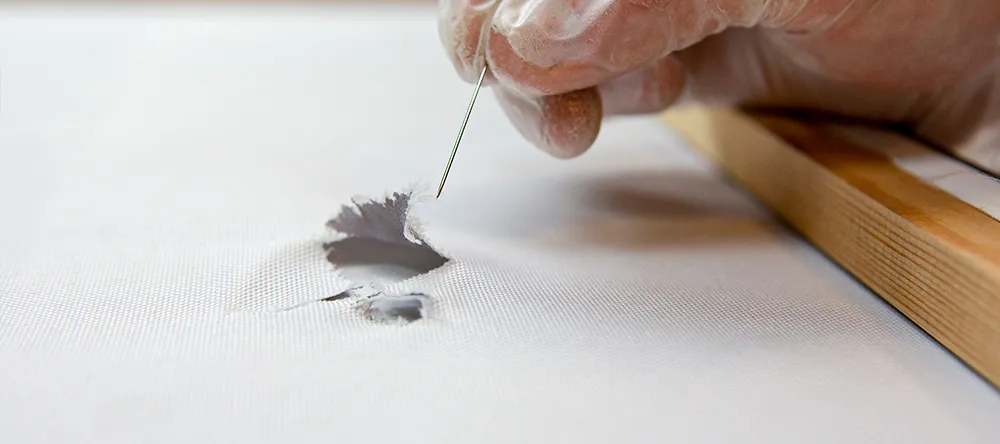How to Fix a Ripped Canvas
Want to know how to fix a ripped canvas with a very small budget? Learn how to repair a canvas tear with our handy guide!
Those who’ve experienced it will be able to confirm that there are few things more frustrating than accidentally tearing a hole in your canvas print.
Damaging a favorite painting or canvas print of a wedding photo might feel like a small catastrophe. But don’t let frustration get the better of you – take a deep breath and stay calm. There are many effective techniques for how to fix a torn canvas out there, and most of them are easy enough to do yourself!
What you’ll need:
-
Spare patch of canvas
-
Acid-free glue (or gel medium/acrylic matte medium)
-
Needle (or similar fine tool)
-
Glue brush
-
Gesso
Steps in Brief:
-
Prepare your canvas patch. You can buy unprinted canvas fabric in an art supply store or online
-
Stick patch to back of damaged canvas. For this you can use acid-free glue/gel medium/acrylic matte medium
-
Wait for a couple of minutes. Hold patch in place so it bonds with your canvas – but don’t let it dry completely
-
Fix small defects. While fabric is still slightly damp, remove small canvas threads around edges of tear using a needle
-
Apply a binding agent. If necessary, coat edges of tear with gesso (and apply paint to hide gesso once it’s dried)
Read on to learn about every step of the process in more detail!
How to Fix a Torn Canvas – Our Tried and Tested Method
Once the initial panic has subsided, just follow our simple instructions below and you should have no problems concealing the worst of the damage.

The basic technique is straightforward – you stick a patch of canvas material to the back of your canvas in the place where it’s been ripped. Then with the damaged section of canvas glued in position against the new patch, you tidy up the torn fibers at the edge of the tear so that they’re as hard to notice as possible.
Ready? Then it’s time to take care of business MacGyver style!
Step 1: Stick Your Patch in Place

The first thing to do is to prepare your patch. You’ll need a spare piece of canvas large enough to cover the full extent of the tear.
The canvas patch should be applied to the back of the torn area using acid-free glue. Why acid-free? The reason’s simple: acid-free glue won’t get discolored over time or attract impurities from the air, so it should remain as inconspicuous as when it’s first applied.
Note: if your canvas is a painting rather than a photo print, you might want to use gel medium or acrylic matte medium instead of glue.

Once the patch is carefully positioned over the affected area, press it down firmly. You’ll want to hold it in place long enough so that it’s started to bond, but bear in mind that the next step should be done while the canvas material is still damp from the glue.
*(Before moving on to Step 2, turn the canvas around and wipe away any spare glue or gel that might have seeped through to the front.)
Step 2: Tidy Up the Threads Around the Tear

Well, your canvas should look much better already. But only the large-scale damage has been mended so far.
There’s probably also be plenty of small-scale damage to the individual canvas fibers along the edges of the rip. If you can repair these damaged edges, you’ll bring your canvas even closer to its former condition.
You need to work from the front of the canvas now. Take a needle or any similar fine tool (such as tweezers or a sewing pin) and unpick the threads along the edges of the tear.
Then flatten and interweave the unpicked canvas fibers so that the edges of the tear mesh together as neatly as possible.

As the glue from your patch dries, it will hold the interwoven fibers securely in position, sealing up the tear and thus repairing the damage to your picture.
Step 3: Fixing Your Ripped Canvas with Gesso
Once the glue is dry, it’s time to take a step back and have a good look at your canvas. If you’re satisfied with your work, congratulations. But you might decide the tear is still too noticeable – and if so, some additional touch-ups will be necessary.
One of the best substances to use here is gesso
A white paint mixture consisting of a binder mixed with gypsum/chalk, gesso is used on canvas as a base layer for paint and other substances. But it’s also an effective binding agent, and makes a great substitute for glue because it’s barely noticeable once it’s dried.
Apply it to the front of your canvas and a chemical reaction will take place within the layer of gesso, binding together the edges of the tear even more closely.
But of course any gesso you apply will show up white – which means you’ll then need to touch up the coated area yourself using paint. So unless you’re super-confident in your artistic skills, we’d recommend applying gesso to the smallest area possible.
Try coating just the very edges of the tear. Then you’ll just need to concentrate on finding the right colors of paint to touch up your picture, rather than having to worry about the fine detail.

While this probably won’t give you that “good as new” appearance, the results should still be convincing enough. At first glance people shouldn’t be able to tell there’s been any damage at all.
What If I’ve Damaged My Canvas Really Badly?
What can you do if your canvas has suffered damage so bad that it seems irreversible – maybe an L-shaped tear right across your beautiful vacation print, or a nasty slash causing a tragic rift in that wedding picture?

Well, sadly you might be out of options here. There’s only so much a DIY repair job can fix, and serious damage usually means you’re left with one option – getting your image printed anew.
However, thanks to the great pricing offered by CanvasDiscount.com, buying a new print will come at a small cost when weighed against the stress you’ll avoid
So you should always take a close look and evaluate the damage before discarding any ripped canvas print, but sometimes starting over is the best way – it won’t cost you a fortune.
And canvas prints produced by CanvasDiscount.com are exceptionally robust and durable – so if it’s treated with the minimum of care, this time your print should stay in great condition for a whole lifetime.
General Questions about the Durability of Canvas Prints
-
Canvas prints are known for their durability and long-lasting qualities, making them an excellent investment for anyone looking to display their favorite photos or artwork. With proper care and maintenance, canvas prints can last for decades without fading or losing their vibrancy, if exposed away from direct sunlight or environments with high humidity. Plus, the stretched canvas design eliminates the need for a frame and glass cover, making canvas prints a convenient and hassle-free option for decorating your home or office. Canvas prints offer the advantage of being resistant to accidental knocks and breaks, as they don't require a glass cover that could shatter. So, if you're wondering whether canvas prints last, the answer is a resounding yes!
-
Canvas prints are highly durable and long-lasting, with little risk of cracking or damage over time. Unlike traditional paper prints, canvas prints are made with sturdy canvas fabric that resists cracking and tearing. In addition, the wooden frame used to stretch the canvas is designed to hold the print securely in place, minimizing the risk of warping or other types of damage. So if you're considering a canvas print for your home or office, you can feel confident that it will provide a beautiful and long-lasting addition to your decor without the worry of cracking or damage.
-
Canvas has been used for centuries in art and has a reputation for being a long-lasting material. However, the lifespan of canvas can vary depending on factors such as the quality of the canvas, how well it is maintained, and the environmental conditions it is exposed to. A high-quality canvas that is stored and displayed properly can last for decades, while a lower quality canvas that is not well cared for may deteriorate much more quickly. With proper handling, storage, and display, a canvas can maintain its quality and vibrancy for a very long time.
-
When it comes to print longevity, canvas prints are often the winner in this area. While there are many factors that affect the longevity of a print, canvas is known for its durability, making it a popular choice for home decor and art enthusiasts alike. Unlike paper prints that can easily tear, fade, or deteriorate over time, canvas prints are more resistant to wear and tear and can last for decades when properly cared for. Additionally, canvas prints have a classic and timeless feel that can elevate the aesthetic of any room. The texture of the canvas adds depth and dimension to the print, making it a more dynamic and engaging piece of art. Overall, if you're looking for a print that will stand the test of time, a canvas print is an excellent option to consider.
-
It's generally not necessary to seal canvas prints unless you plan to display them in very humid environments or under direct sunlight. High-quality canvas prints made by reputable providers are often already treated to withstand moisture and fading. Sealing canvas prints yourself can be a good precaution, but it's not always required. However, if you live in a humid area or plan to hang your canvas print in a bathroom or other damp location, it may be beneficial to seal it for extra protection. Just keep in mind that sealing your canvas print may alter its appearance, so it's important to test any sealant on a small, inconspicuous area first.
-
To make your canvas shine, you can apply a varnish or a clear acrylic coat to protect and enhance the colors of your artwork. The varnish or acrylic coat will add a glossy or satin finish, which can also make the canvas print look more professional. Applying a protective coat can also prevent fading and damage from environmental factors such as humidity and sunlight. This can extend the life of your artwork and keep it looking beautiful for years to come.
-
To protect your canvas from mold, it's important to store it in a dry, cool place, away from direct sunlight and moisture. Use a dehumidifier or air conditioner to maintain a consistent humidity level in the storage area. If you suspect that your canvas has been exposed to mold, you can use a soft brush or cloth to remove any visible mold and then treat the canvas with a mold-killing solution. Always test the solution on a small, inconspicuous area of the canvas before applying it to the entire surface.